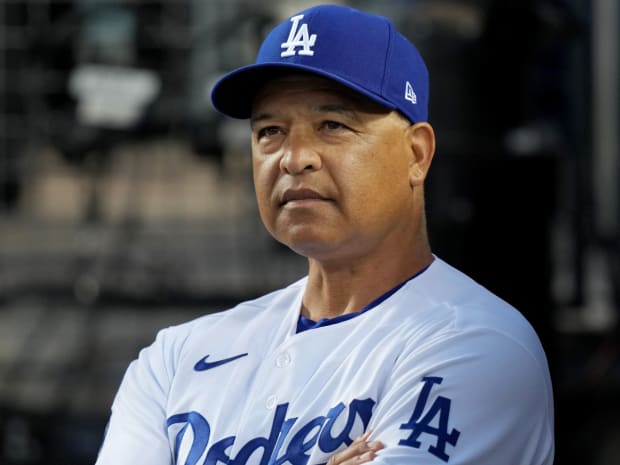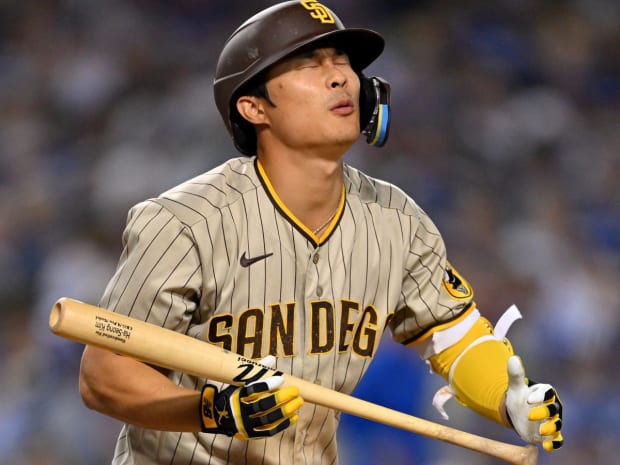LOS ANGELES – The great Sandy Koufax, who averaged almost eight innings in his seven postseason starts, took his usual lower box seat to watch another Dodgers relay race of pitchers take place. Imagine if Truffaut were around to watch Tik Tok videos and you get a sense of how much playoff baseball has changed.
By now the Dodger October postmodern script is familiar: pull the starting pitcher as the lineup turns over a third time and match up a cadre of relievers against certain “runways” of hitters in the opposing lineup. Los Angeles manager Dave Roberts, for the 71st time in running 78 postseason games, yanked his starter without letting him throw 100 pitches. Julio Urías, his best pitcher, was gone after 79 pitches and five innings. The manager then deployed four relievers who combined for four shutout innings to preserve a 5–3 Dodgers win over the Padres on Tuesday night in Game 1 of the National League Championship Series.
But there was one wrinkle this time to the Dodger blueprint: without Kenley Jansen (who left after last season for Atlanta as a free agent) and Craig Kimbrel (left off the roster because of ineffectiveness), Roberts for the first time has no established closer in October. No problem.
Here’s what Roberts did: he used his four best relievers in reverse order.
His best arm, Evan Phillips, was first in because San Diego’s best hitters, Juan Soto and Manny Machado, were up in the sixth. And he closed the game with Chris Martin, who over seven seasons with seven major league organizations had saved just nine games, none of them in the postseason. In between, Roberts used lefthander Alex Vesia, a high fastball savant, and righthander Brusdar Graterol, a power sinkerballer who threw one pitch, which Machado hit into the teeth of rain and wind in left field for a dramatic out.

Kirby Lee/USA Today Sports
Roberts and the Dodgers are turning baseball upside down. Instead of scripting who will pitch the ninth, they don’t worry about it until they get there. Roberts’s game management in this series is built entirely around getting the right matchups against Soto and Machado in the last four innings of a game. As for the endgame, Tuesday it was Martin, but if the Dodgers win this series, you might see three different pitchers finish victories.
No closer? The Dodgers see it as a feature, not a bug.
“We think our depth will be a factor,” Roberts said, “even in a five-game series.”
So good are the Dodgers, they are playing not just to win the World Series but also to be coronated as one of the greatest teams ever. They tied for fourth all-time in regular season wins (111) and stand alone in fourth for run differential (+334). They have the best pitching staff in the majors this year, the best offense and, as far as turning batted balls into outs, the best defense, which showed in the biggest moment of the game: a slick double play turned by Gavin Lux and Trea Turner to end the sixth inning with the tying runs on.
Their path to get there is built precisely on pitcher relay races like the one in Game 1. The Dodgers know what to do with a lead. In the regular season they were 76–13 when scoring first, the best such record in the National League since 1920. They scored the first five runs in Game 1. Roberts’s calculus to preserve the lead this time looked like this:
- Urías came out because he started hanging his curveball in the fifth while making mistakes over the plate—and the heart of the order was coming up a third time.
- Phillips came in to throw his power slider, which held hitters to a .160 average this year.
- Vesia came in because Roberts wanted a lefty on Jake Cronenworth, Trent Grisham, Jurickson Profar (to bat from his weaker side) and Soto. Lefties hit .109 against Vesia’s high-spin fastball.
- Martin, a cutter specialist, threw 11 pitches, all between 91 and 96 mph.
Before the eighth inning, Roberts huddled with coaches Danny Lehmann and Mark Prior about how to script that inning. To give you an idea of how seriously the Dodgers take these decisions, Lehmann’s title is Game Planning and Communications coach. After about three minutes, they decided to have Graterol on Machado. With some freakish meteorological help on a Southern California night, it worked perfectly.
And so, the Dodgers’ mastery over the Padres continues. They are 15–5 against San Diego this year, 76–33 over the past six years. In their last 17 games against the Padres at Dodger Stadium, the Dodgers are 15–2 while outscoring San Diego 101-44. This “rivalry” is starting to look like Lucy holding the football for a Charlie Brown placekick. You know where each episode is heading.

Jayne Kamin-Oncea/USA TODAY Sports
But don’t be fooled: Tuesday night’s margin was thin. The disadvantage of having to play three wild-card games caught up to the Padres. Los Angeles jumped on No. 4 starter Mike Clevinger, who has pitched sporadically because of injury and illness. They pounded five extra-base hits among their six hits, five of those off Clevinger’s modest fastball.
Los Angeles did nothing against the San Diego bullpen and survived several hard-hit balls by Padres hitters. Five San Diego outs resulted from balls hit 100 mph or more, one short of the Padres’ season high.
But still, the Dodgers’ game management and bullpen depth made the outcome almost without doubt. This is how Dodgers-Padres games tend to end up, as well as postseason games managed by Roberts. He is 45–33 in the postseason, a .577 winning percentage, the equivalent of a 93-win team against the most elite competition. Among managers with at least 40 games in the postseason, only Hall of Famers Joe McCarthy (.698), Sparky Anderson (.618), Joe Torre (.592) and Casey Stengel (.587) won postseason games at a better clip than Roberts.
Truffaut was one of the founders of the French New Wave in cinema. He rejected convention. Roberts is part of this Postseason New Wave. Lest you think it cannot work, remember how the Braves won the World Series last year—they used relief pitchers to cover more postseason innings than starting pitchers.







